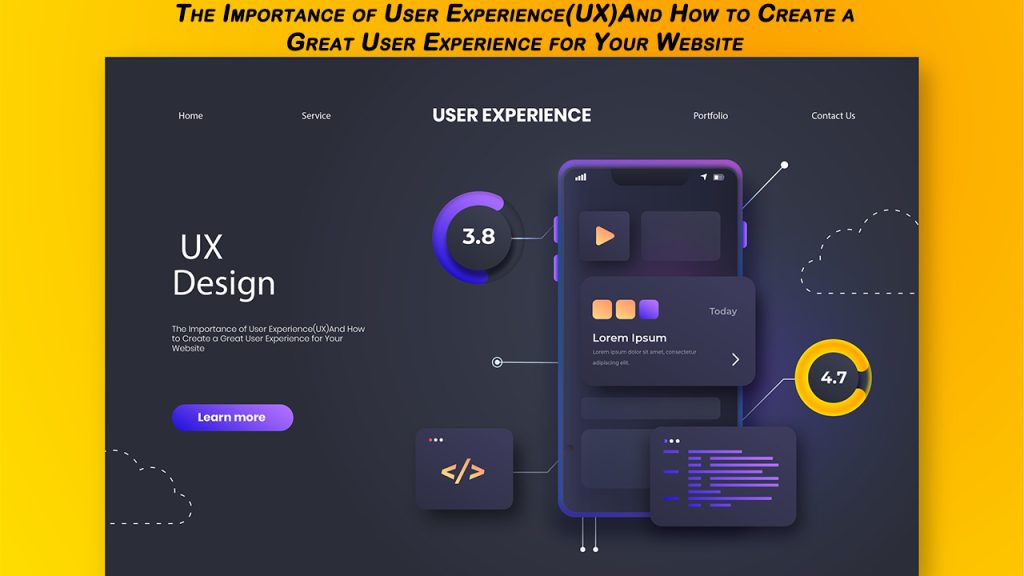In the digital realm, user experience (UX) isn’t just a buzzword; it’s the cornerstone of online success. Your website’s UX can make or break your online presence, affecting visitor satisfaction, search engine rankings, and even your bottom line.
Join us on a journey to unravel the significance of UX and discover the secrets to crafting an exceptional web experience. Whether you’re a seasoned website owner or just starting, understanding and implementing these strategies will propel your site to new heights.
Let’s discover and create a website that visitors love and Google rewards!
The Significance of User Experience (UX)
User Experience (UX) is the heart of your website’s success. It keeps visitors engaged and happy. Plus, it’s not just about users; it also impacts your site’s credibility.
Good UX translates into trust and authority. And if you need proof, the stats say it all. Your website’s UX directly affects your rankings, making it a key player in your online visibility. It’s not just a design choice; it’s a strategic move that can significantly boost your digital presence.
By prioritizing UX, you’re not only enhancing user satisfaction but also signaling to search engines that your site is a valuable resource, driving more traffic your way.
Elements of User Experience (UX)
In the online world, the User Experience (UX) can be the make-or-break factor for your website’s success. To excel in this digital landscape, you must master several key elements:
Website Speed and Performance
- Slow-loading pages can frustrate visitors and harm your UX. Speed is crucial. Optimize images, use efficient coding, and consider content delivery networks.
- Ensure your site works seamlessly on mobile devices, catering to users on the go. Focus on responsive design, minimize pop-ups, and streamline your mobile content.
Responsive Design
- Your website should look fantastic, no matter the device it’s viewed on. Test on various instruments and screen sizes for a flawless experience.
- Ensure your site is cross-browser compatible so it looks and functions well on different browsers.
Intuitive Navigation
- Easy navigation ensures visitors find what they need effortlessly. Organize menus logically and include a search feature for quick access.
- Implementing compelling Call-to-Actions guides users effectively. Craft concise, action-oriented CTAs that encourage user interaction.
Content Relevance
- Craft content that captivates and informs your audience. Use storytelling, visuals, and multimedia to enhance engagement.
- Incorporate keywords organically to enhance UX and SEO. Research and select relevant keywords to integrate naturally within your content.
Usability and Accessibility
In the ever-evolving digital landscape, usability and accessibility are the pillars of a successful website. To ensure your site caters to a diverse audience, you must conduct usability tests and gather feedback to pinpoint areas of improvement.
Making your website accessible to everyone, regardless of disabilities, is paramount. Use alt text for images, consider screen reader compatibility, and prioritize enhancing accessibility features like keyboard navigation and readable fonts.
A more accessible website not only pleases users but also garners favor with search engines, improving your site’s SEO and overall user satisfaction.
Visual Appeal
Visual appeal is pivotal in delivering an exceptional user experience on your website. Design, the first point of contact for users, can captivate or deter them.
Consistency in branding and aesthetics ensures a cohesive and trustworthy look, fostering a sense of reliability. Thoughtful typography and color choices go a long way in making your content enjoyable to consume.
Furthermore, multimedia, when used effectively, can engage users and enrich their experience. Together, these elements create a visually enticing and user-friendly website that keeps visitors returning for more.
Mobile User Experience (UX)
Mobile User Experience (UX) is no longer an afterthought – it’s a top priority. With the increasing number of users on mobile devices, your website must offer a seamless mobile experience.
Mobile-responsive design isn’t just about aesthetics; it directly impacts your site’s SEO performance, affecting search engine rankings.
Additionally, if you have a mobile app, its usability and accessibility are crucial in enhancing the overall UX. It’s time to embrace the mobile wave and ensure your digital presence caters to users on the go.
User Feedback and Data Analysis
Gathering user feedback is a cornerstone of enhancing User Experience (UX). Surveys and questionnaires provide valuable insights into user preferences, illuminating what elements resonate with your audience.
Additionally, tools like Google Analytics offer a deeper understanding of user behavior, allowing you to track what’s working and what isn’t on your website.
Continuous improvement, based on user feedback, is critical to maintaining a strong UX. It involves consistently analyzing the feedback and data you gather, which enables you to make informed changes. Embracing iterative design is the path to ongoing UX enhancement.
It means using the feedback and insights you’ve collected to make gradual, user-focused improvements, ensuring your website stays in sync with user expectations and evolving trends.
SEO Optimization for UX
Optimizing your website for SEO while prioritizing User Experience (UX) is an intelligent strategy. Here’s how:
- Integrating keywords naturally into content: Blend relevant keywords seamlessly into your content, making it valuable to users and search engines.
- Enhancing website speed and performance for SEO benefits: Speed matters. Faster-loading pages not only delight users but also earn favor with search engines.
- Mobile optimization and SEO: With mobile devices rising, ensure your site is mobile-friendly to boost SEO rankings.
- Optimizing images and multimedia for faster loading: Compress and optimize visuals to maintain a speedy site, pleasing users and search engines alike.
Conclusion
In conclusion, understanding the importance of User Experience (UX) is the first step towards a successful website. We’ve explored vital takeaways, such as the impact of UX on visitor engagement, SEO rankings, and brand credibility.
Prioritizing elements like speed, responsive design, intuitive navigation, and relevant content can transform your website.
Remember, a well-designed UX not only keeps users happy but also signals to search engines that your site is worth promoting. So, make UX a priority, and watch your online presence soar.
FAQs
What is the importance of user experience on a website?
User experience (UX) on a website is crucial because it directly affects how visitors perceive and interact with your site. A positive UX leads to satisfied users, longer visits, and higher chances of achieving your website’s goals.
What makes a great user experience in UX?
A great user experience (UX) is characterized by a website that is easy to navigate, providing clear menus and seamless interactions. It also offers engaging, relevant content that meets users’ needs and expectations.
What are the benefits of user experience?
User experience (UX) brings multiple benefits, from increased visitor satisfaction and longer time spent on your site to improved search engine rankings. It also boosts brand credibility, helping your website stand out in the digital landscape.





